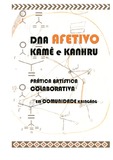| dc.creator | Mallmann, Kalinka Lorenci | |
| dc.date.accessioned | 2019-02-26T20:56:13Z | |
| dc.date.available | 2019-02-26T20:56:13Z | |
| dc.date.issued | 2018-03-22 | |
| dc.identifier.uri | http://repositorio.ufsm.br/handle/1/15763 | |
| dc.description.abstract | DNA Affective kamê and kanhru refers to a research in visual poetics, involving collaborative artistic practices in community starting from the activation of the specific modes of social organization of the kaingáng indigenous culture through a network of exchanges, connectivity and affections. In this way, we seek to approach the artistic and critical production, which investigates these singular ways of doing and thinking about art, addressing the specificities of these practices and their methodologies. Thus, the contributions of Grant H. Kester and Pablo Helguera are used to problematize collaboration in contemporary art and to correlate these practices with the concept of socially engaged art. In the same way, it refers to the theoretical production of Antonio Lafuente, which allows us to meditate around these emerging collaborative processes and the production of the common. The art actions of the proposed project were carried out in kaingáng territory, in the Terra do Guarita community, in the northwest of the state of RS, from audiovisual creation laboratories. These activities foster the local issues and the protagonism of the community facing an open and dynamic artistic process. An action was also taken in web art that allowed us to think about the connectivity existing in these collaborative processes. In this sense one uses of the reflections of Roy Ascott, among other theoretical references concerning the scope of the art and technology. This dissertation comes to understand that collaborative artistic practices in communities are conceived and constituted in a specific way. In addition to being guided by an ethical, empathetic and supportive sense, attributing meaning to "being together" as a transforming power. | eng |
| dc.description.sponsorship | Coordenação de Aperfeiçoamento de Pessoal de Nível Superior - CAPES | por |
| dc.language | por | por |
| dc.publisher | Universidade Federal de Santa Maria | por |
| dc.rights | Attribution-NonCommercial-NoDerivatives 4.0 International | * |
| dc.rights.uri | http://creativecommons.org/licenses/by-nc-nd/4.0/ | * |
| dc.subject | Arte contemporânea e tecnologia | por |
| dc.subject | Prática artística colaborativa | por |
| dc.subject | Comunidade kaingáng | por |
| dc.subject | Contemporary art and technology | eng |
| dc.subject | Collaborative art practice | eng |
| dc.subject | Kaingáng community | eng |
| dc.title | DNA afetivo Kamê e Kanhru: prática artística colaborativa em comunidade Kaingáng | por |
| dc.title.alternative | DNA afetivo Kamê - Kanrhu: colaborative artistic practice in the Kaingáng community | eng |
| dc.type | Dissertação | por |
| dc.description.resumo | DNA Afetivo kamê e kanhru diz respeito a uma pesquisa em poéticas visuais, envolvendo práticas artísticas colaborativas em comunidade a partir da ativação dos modos específicos de organização social da cultura indígena kaingáng por meio de uma rede de trocas, conectividade e afetos. Dessa forma, busca-se aproximar da produção artística e crítica, que investiga esses modos singulares de se fazer e de se pensar em arte, abordando as especificidades desses fazeres e suas metodologias. Sendo assim, se utiliza das contribuições de Grant H. Kester e Pablo Helguera, para problematizar a colaboração na arte contemporânea e correlacionar essas práticas com o conceito de arte socialmente engajada. Do mesmo modo, referencia-se à produção teórica de Antonio Lafuente, que proporciona meditarmos em torno desses processos colaborativos emergentes e da produção do comum. As ações em arte do projeto proposto foram realizadas em território kaingáng, na comunidade Terra do Guarita, no noroeste do estado do RS, a partir de laboratórios de criação audiovisual. Essas atividades fomentam as questões do local e o protagonismo da comunidade diante um processo artístico aberto e em fluxo dinâmico. Também realizou-se uma ação em web arte que permitiu pensarmos na conectividade existente nesses processos colaborativos. Nessa acepção utiliza-se das reflexões de Roy Ascott, dentre outras referências teóricas concernentes ao âmbito da arte e tecnologia. Essa dissertação vem a compreender que as práticas artísticas colaborativas em comunidades são concebidas e se constituem de forma específica. Além de serem guiadas por um senso ético, empático e solidário, atribuindo sentido em “estar juntos” como potência transformadora. | por |
| dc.contributor.advisor1 | Oliveira, Andréia Machado | |
| dc.contributor.advisor1Lattes | http://lattes.cnpq.br/7243757837987821 | por |
| dc.contributor.referee1 | Goncalves, Eduarda Azevedo | |
| dc.contributor.referee1Lattes | http://lattes.cnpq.br/4375817269121969 | por |
| dc.creator.Lattes | http://lattes.cnpq.br/7115028343840497 | por |
| dc.publisher.country | Brasil | por |
| dc.publisher.department | Artes | por |
| dc.publisher.initials | UFSM | por |
| dc.publisher.program | Programa de Pós-Graduação em Artes Visuais | por |
| dc.subject.cnpq | CNPQ::LINGUISTICA, LETRAS E ARTES::ARTES | por |
| dc.publisher.unidade | Centro de Artes e Letras | por |



